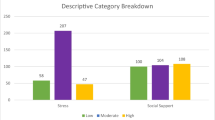Abstract
The psychometric properties of the Multidimensional Scale of Perceived Social Support (MSPSS) were investigated in 222 urban, largely African-American adolescents (68%). High internal consistency was demonstrated, and factor analysis confirmed the three subscale structures of the MSPSS: family, friends, and significant other. Correlations with a family caring scale supported the discriminant validity of the Family subscale. These results confirm the reliability, validity, and utility of the MSPSS with an urban, largely African-American adolescent sample. Implications of the findings are discussed.
Similar content being viewed by others
REFERENCES
Alderman, E. M., Lauby, J. L., & Coupey, S. M. (1995). Problem behaviors in inner-city adolescents with chronic illness. Journal of Developmental and Behavioral Pediatrics, 16, 339–344.
Brandt, P. A., & Weinert, C. (1981). The PRQ—A social support measure. Nursing Research, 30, 277–280.
Canty-Mitchell, J. L. (1996). The caring needs of African American male juvenile offenders.Journal of Transcultural Nursing, 8, 3–12.
Canty-Mitchell, J. L. (2000). Development and testing of the Adolescent Family Caring Scale (submitted for publication).
Cauce, A. M., Felner, R. D., & Primavera, J. (1982). Social support in high-risk adolescents: Structural components and adaptive impact. American Journal of Community Psychology, 10, 417–428.
Cecil, H., Stanley, M. A., Carrion, P. G., & Swann, A. (1995). Psychometric properties of the MSPSS and NOS in psychiatric outpatients. Journal of Clinical Psychology, 51, 593–602.
Dahlem, N.W., Zimet, G. D., & Walker, R. R. (1991). TheMultidimensional Scale of Perceived Social Support: A confirmation study. Journal of Clinical Psychology, 47, 756–761.
Floyd, F. J., & Widaman, K.F. (1995). Factor analysis in the development and refinement of clinical assessment instruments. Psychological Assessment,7, 286–299.
Frey, C. U., & Rothlisberger, C. (1996). Social support in healthy adolescents. Journal of Youth and Adolescence,25, 17–31.
Gavazzi, S. M. (1994). Perceived social support from family and friends in a clinical sample of adolescents. Journal of Personality Assessment, 62, 465–471.
Gorsuch, R. L. (1997). Exploratory factor analysis: Its role in item analysis. Journal of Personality Assessment, 68, 532–560.
Graham, S. (1992). “Most of the subjects were white and middle class”: Trends in published research on African Americans in selected APA journals, 1970–1989. American Psychologist, 47, 629–639.
Grammatik 6.0a, WordPerfect Grammar Checker [computer software]. (1994). Orem, UT: PNovell, Inc.
Hughes, D., Seidman, E., & Williams, N. (1993). Cultural phenomena and the research enterprise: Toward a culturally anchored methodology. American Journal of Community Psychology,21, 687–704.
Kazarian, S. S., & McCabe, S.B. (1991). Dimensions of social support in the MSPSS: Factorial structure, reliability, and theoretical implications. Journal of Community Psychology, 19, 150–160.
Licitra-Kleckler, D. M., & Waas, G. A. (1993). Perceived social support among high-stress adolescents: The role of peers and family. Journal of Adolescent Research,8, 381–402.
Lifrak, P. D., McKay, J. R., Rostain, A., Alterman, A. I., & O'Brien, C. P. (1997). Relationship of perceived competencies, perceived social support, and gender to substance use in young adolescents. Journal of the American Academy of Child and Adolescent Psychiatry, 36, 933–940.
Maton, K. I., Teti, D. M., Corns, K. M., Vieira-Baker, C. C., Lavine, J. R., Gouze, K. R., & Keating, D. P. (1996). Cultural specificity of support sources, correlates and contexts: Three studies of African-American and Caucasian youth. American Journal of Community Psychology,24, 551–587.
Millstein, S. G., Petersen, A. C., & Nightingale, E. O. (Eds.) (1993). Promoting the health of adolescents. New York: Oxford University Press.
Norbeck, J. S., Lindsey, A. M., & Carrieri, V. L. (1981). The development of an instrument to measure social support. Nursing Research, 30, 264–269.
Norusis, M. J. (1994). SPSS Professional Statistics [Computer software]. Chicago, IL: SPSS Inc.
Procidano, M. E., & Heller, K. (1983). Measures of perceived social support from friends and from family: Three validation studies. American Journal of Community Psychology, 11, 1–24.
Secco, M. L., & Moffatt, M. E. K. (1994). A review of social support theories and instruments used in adolescent mothering research. Journal of Adolescent Health, 15, 517–527.
Shafer, M. A., & Boyer, C. B. (1991). Psychosocial and behavioral factors associated with risk of sexually transmitted diseases, including human immunodeficiency virus infection, among urban high school students. Journal of Pediatrics, 119, 826–833.
St. Lawrence, J. S., Brasfield, T. L., Jefferson, K. W., Allyene, E., & Shirley, A. (1994). Social support as a factor in African-American adolescents' sexual risk behavior. Journal of Adolescent Research,9, 292–310.
Tardy, C. H. (1985). Social support measurement. American Journal of Community Psychology, 13, 187–202.
Walter, H. J., Vaughan, R. D., Gladis, M. M., Ragin, D. F., Kasen, S., & Cohall, A. T. (1992). Factors associated with AIDS risk behaviors among high school students in an AIDS epicenter. American Journal of Public Health,82, 528–532.
Wilson, D. K., Rodrique, J. R., & Taylor, W. C. (Eds.) (1997). Health-promoting and healthcompromising behaviors among minority adolescents. Washington, DC: American Psychological Association.
Zimet, G. D., Dahlem, N. W., Zimet, S. G., & Farley, G. K. (1988). The Multidimensional Scale of Perceived Social Support. Journal of Personality Assessment, 52, 30–41.
Zimet, G. D., Powell, S. S., Farley, G. K., Werkman, S., & Berkoff, K. A. (1990). Psychometric characteristics of the Multidimensional Scale of Perceived Social Support. Journal of Personality Assessment, 55, 610–617.
Author information
Authors and Affiliations
Rights and permissions
About this article
Cite this article
Canty-Mitchell, J., Zimet, G.D. Psychometric Properties of the Multidimensional Scale of Perceived Social Support in Urban Adolescents. Am J Community Psychol 28, 391–400 (2000). https://doi.org/10.1023/A:1005109522457
Issue Date:
DOI: https://doi.org/10.1023/A:1005109522457




